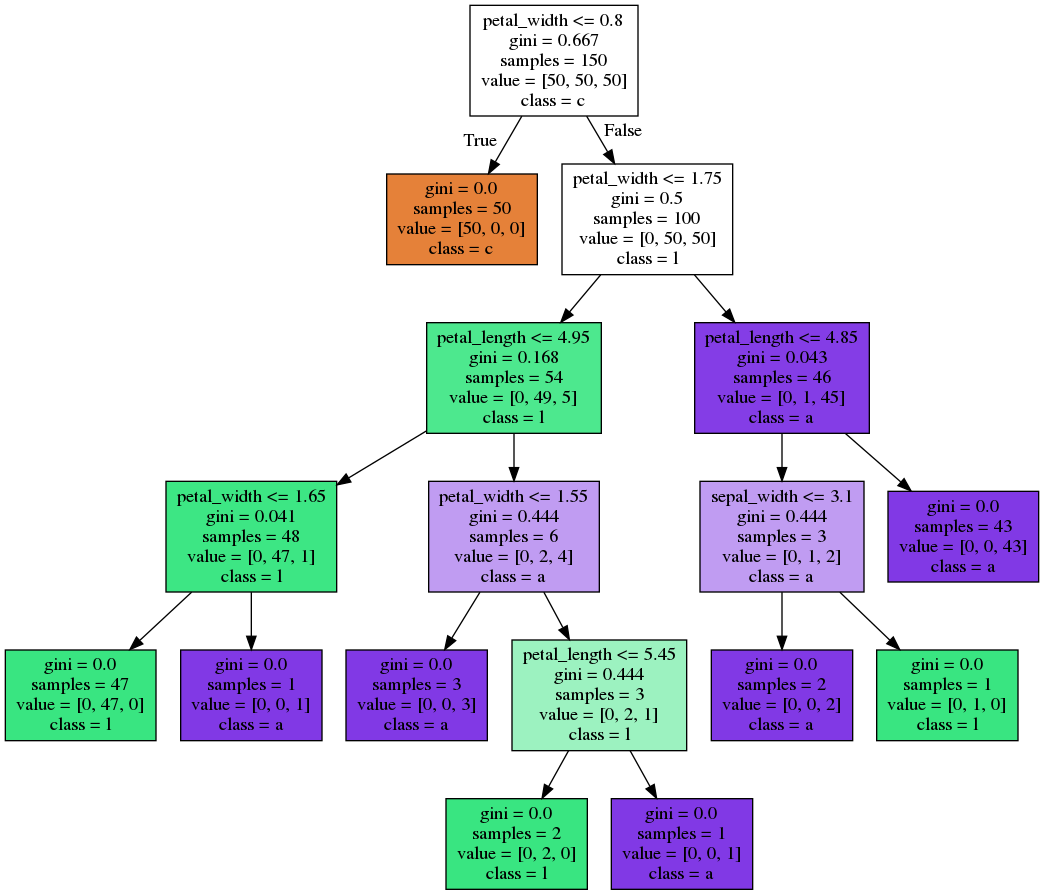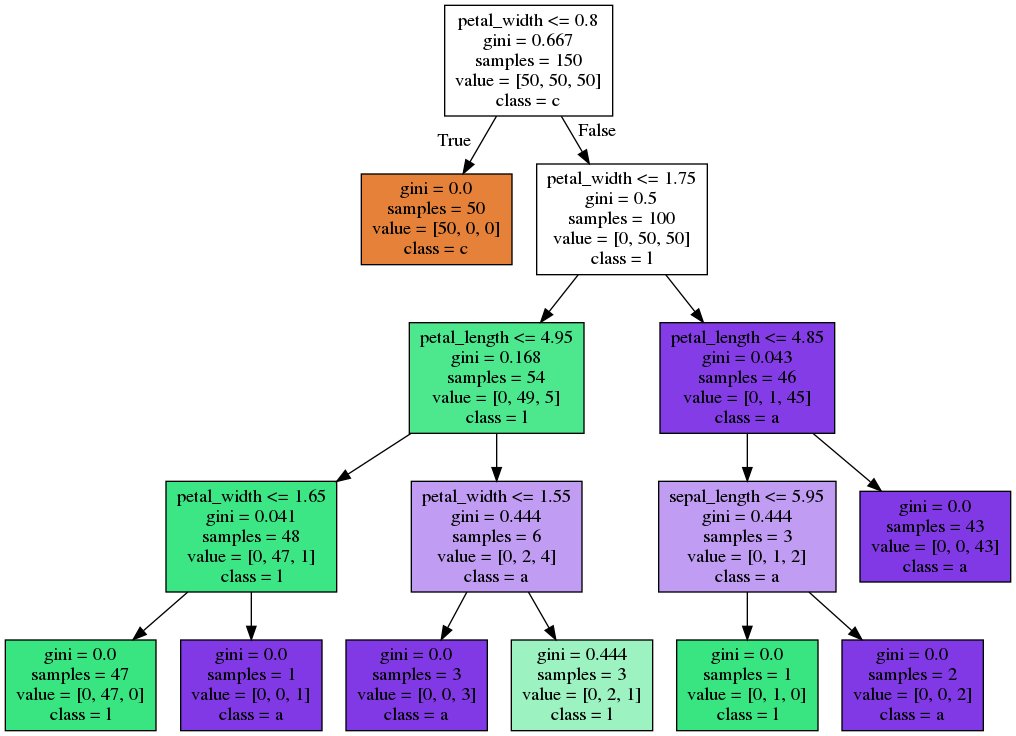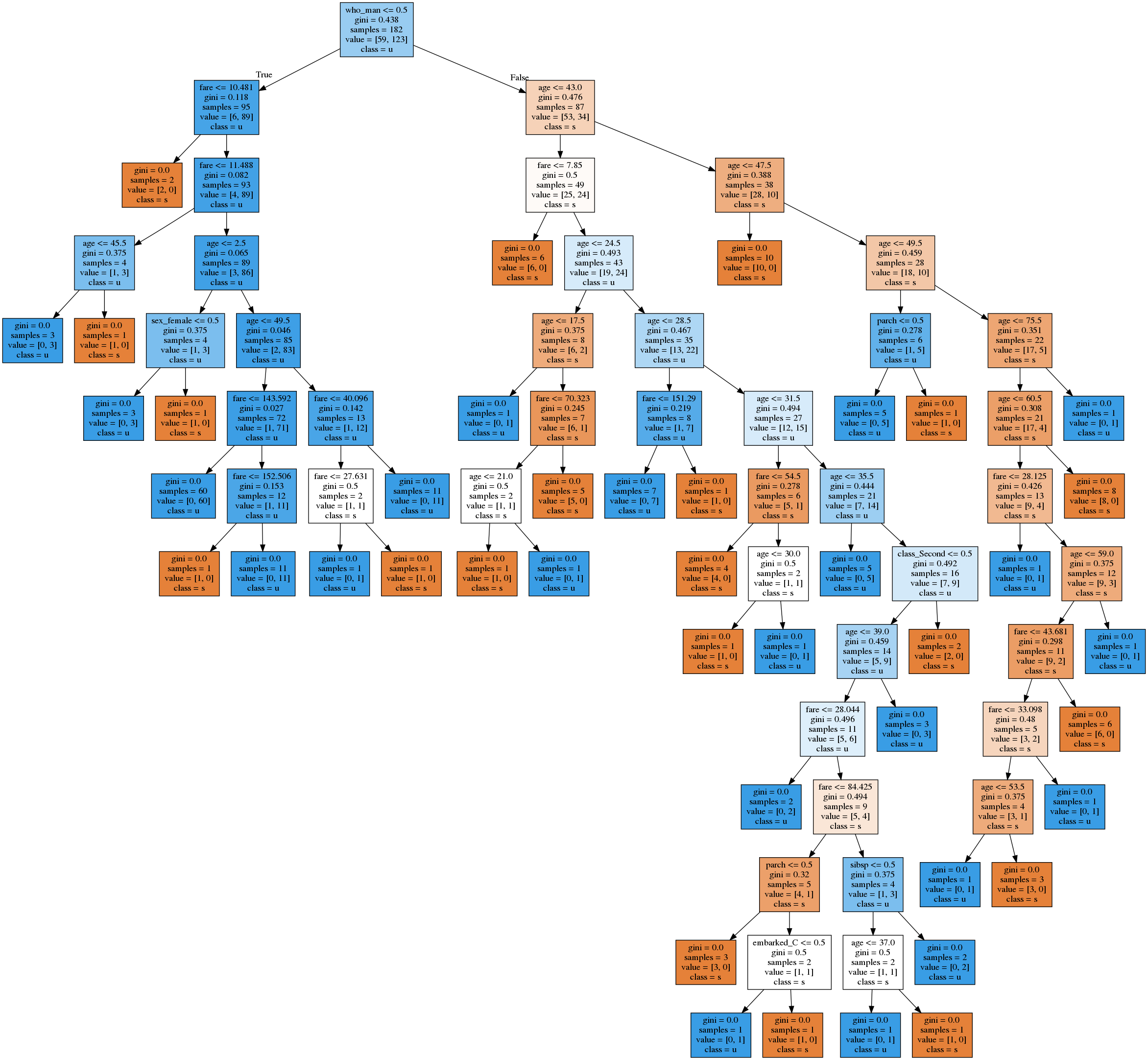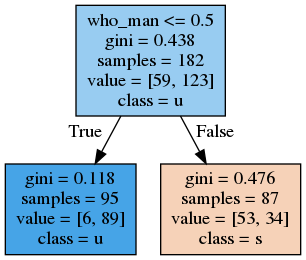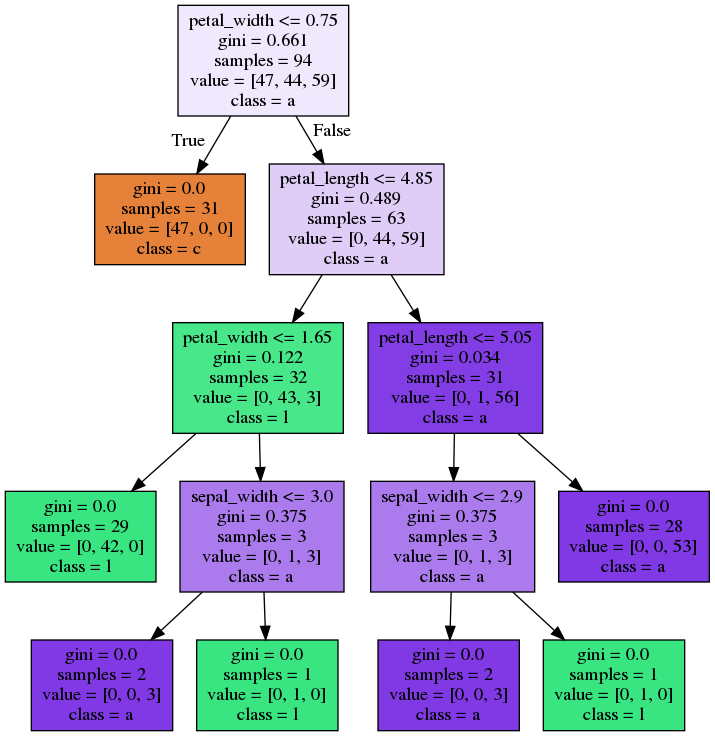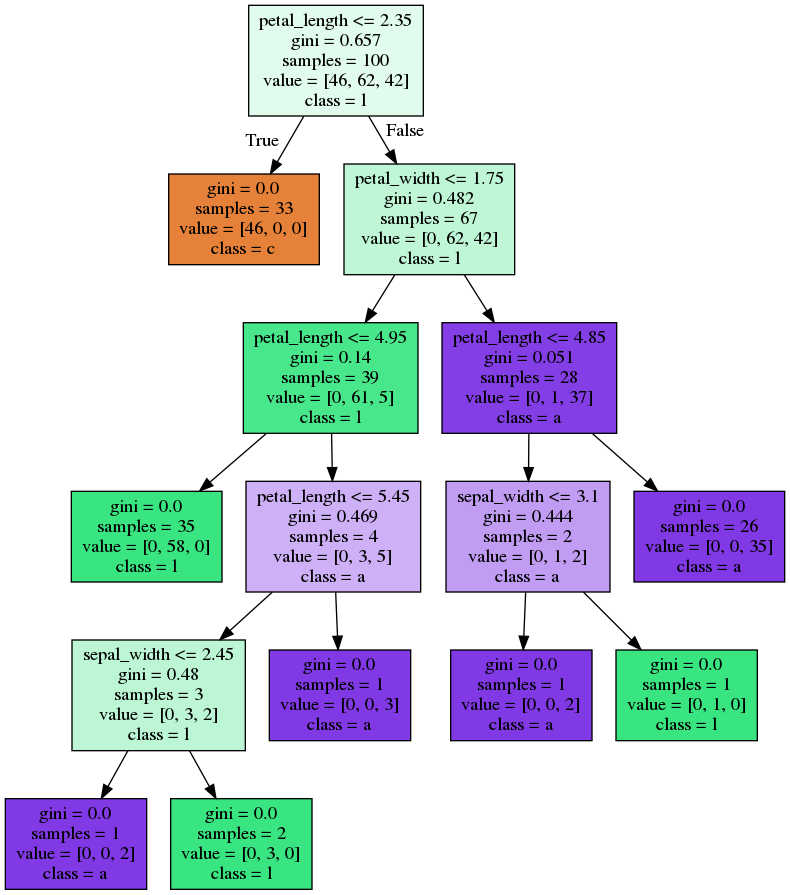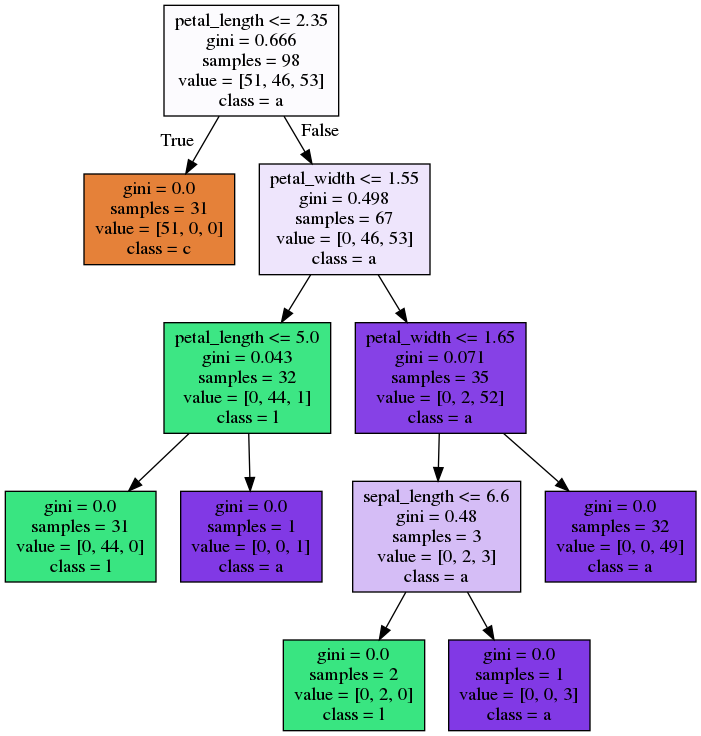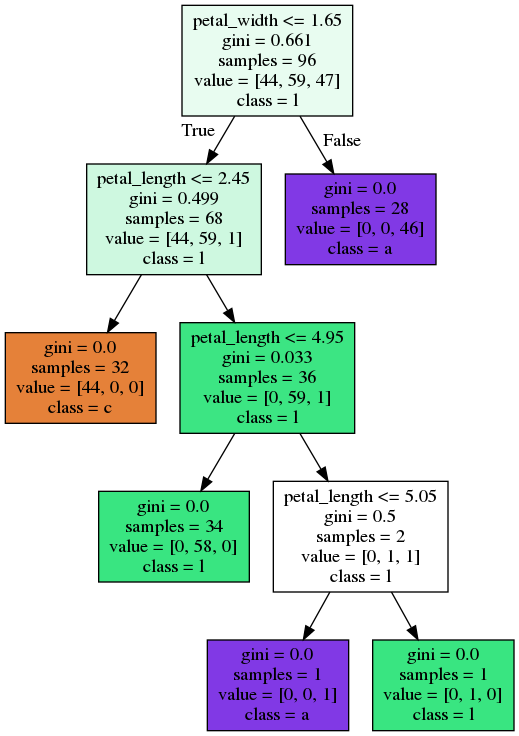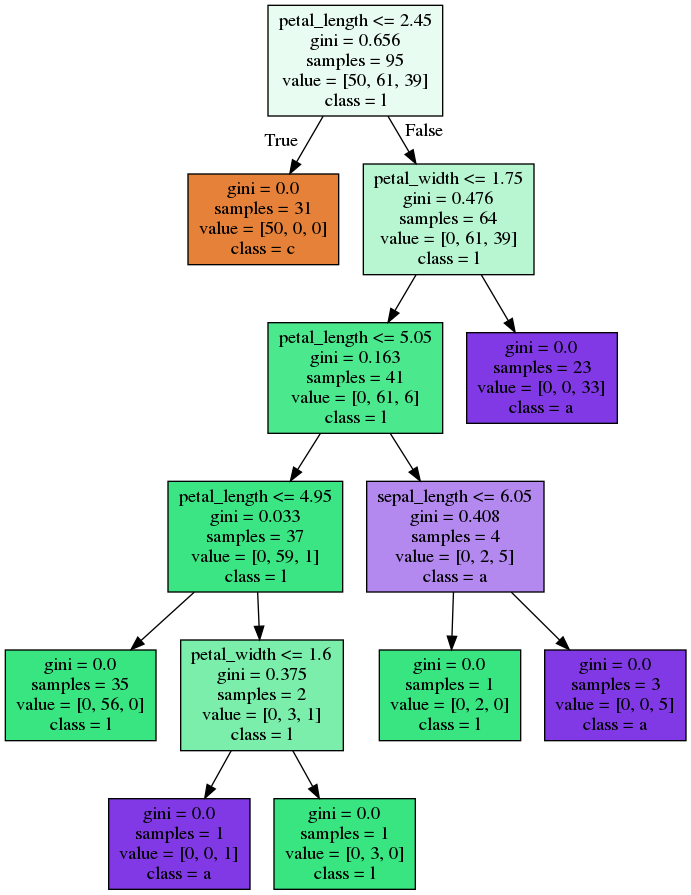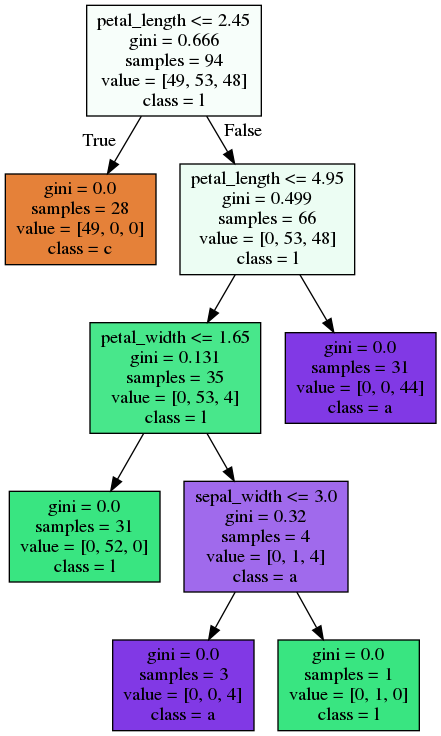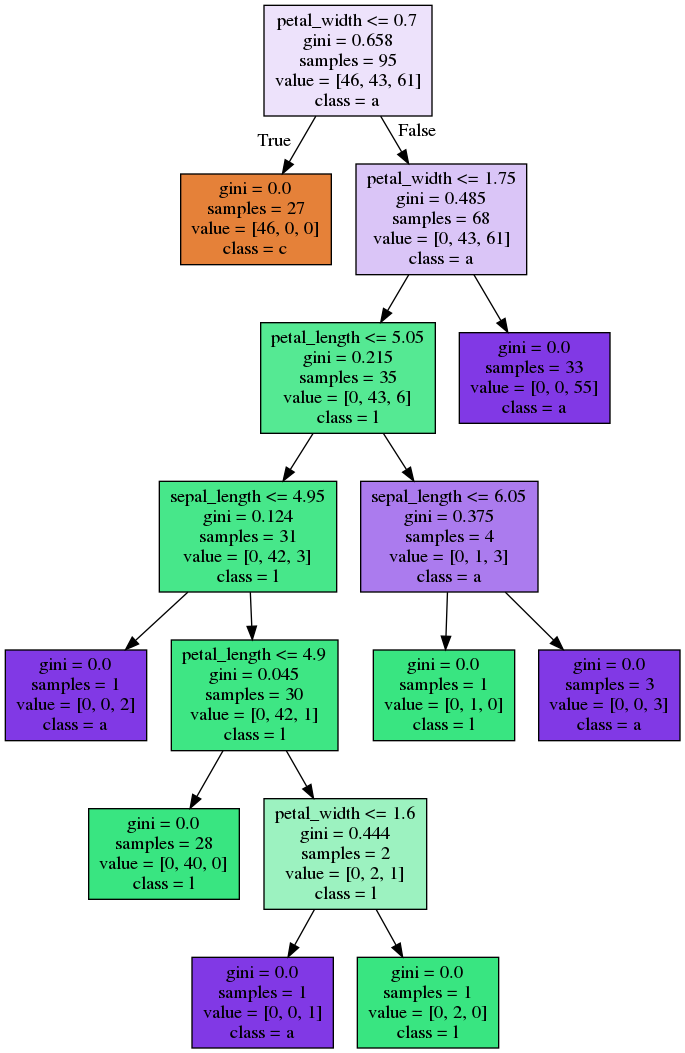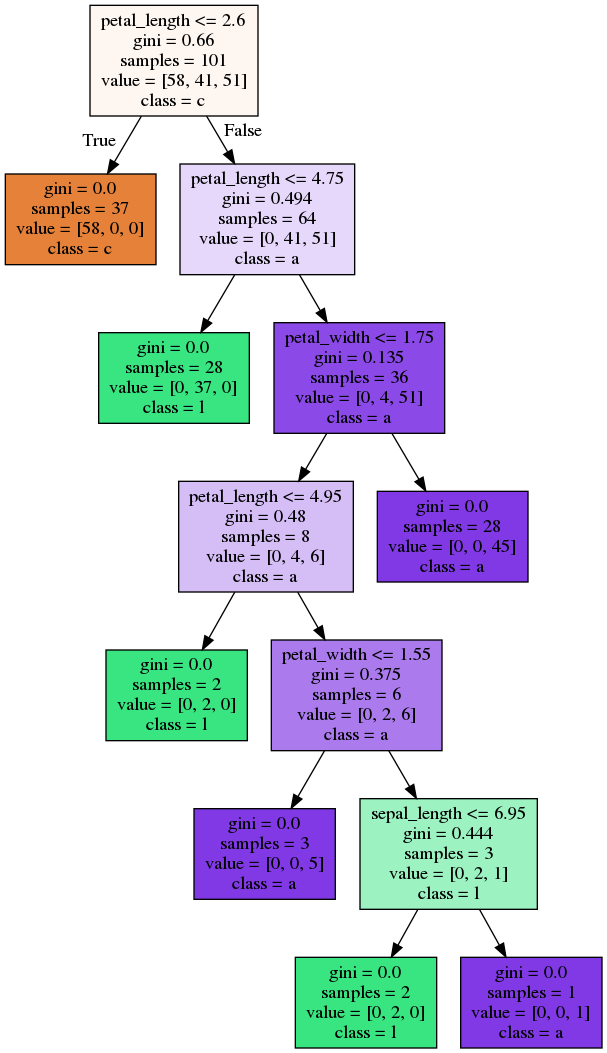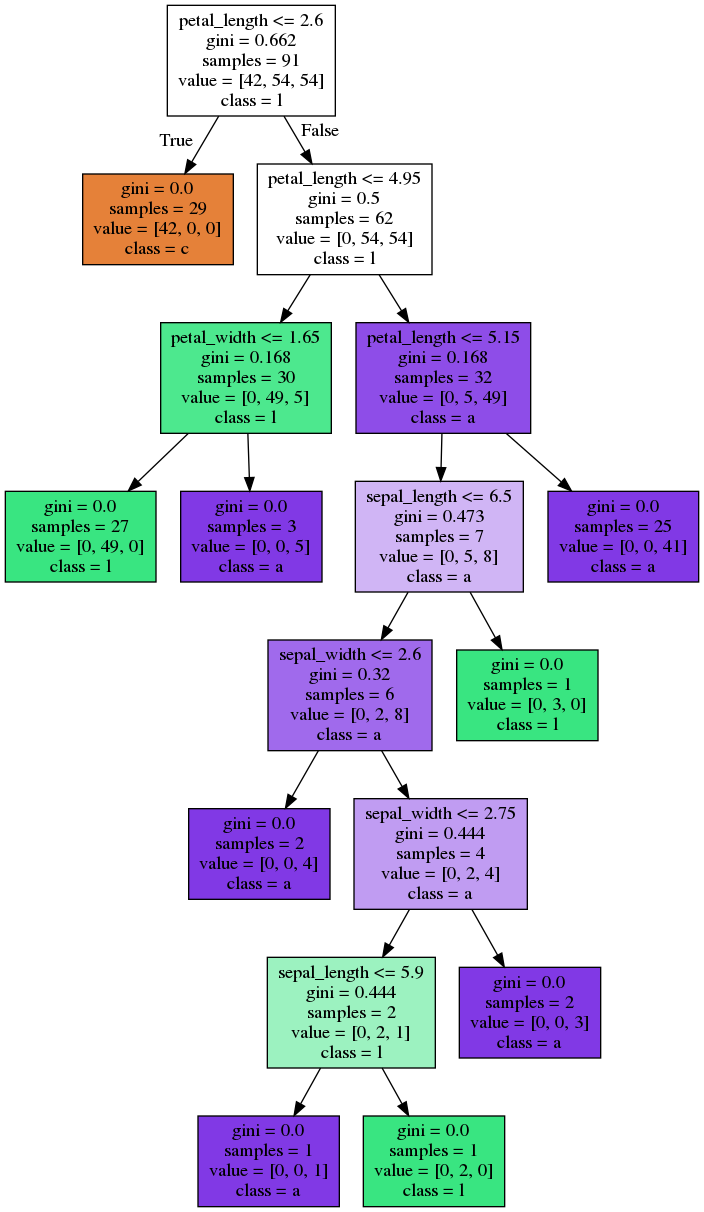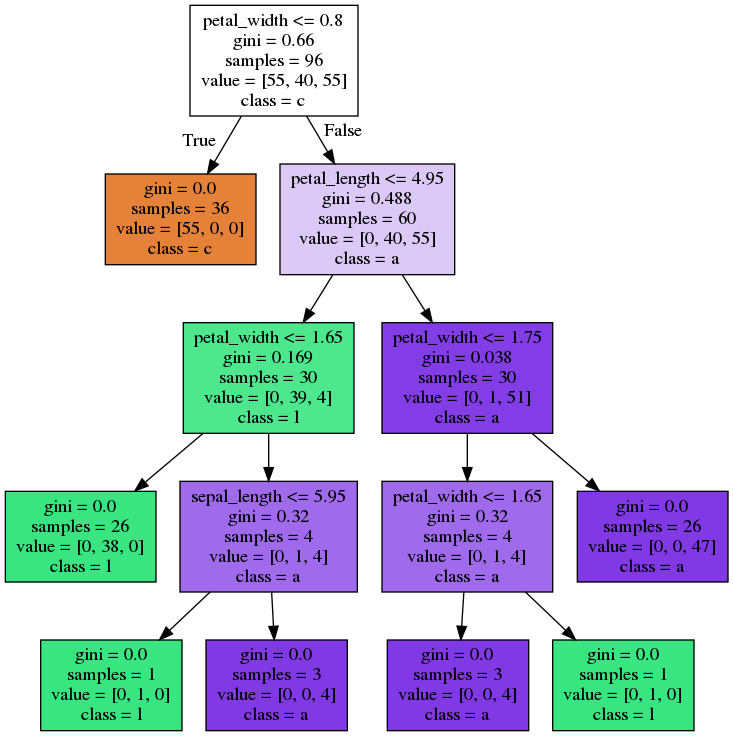BDA-602 - Machine Learning Engineering
Dr. Julien Pierret
Lecture 7
Lecture 7 Agenda
-
Feature Engineering
- Categorical vs Continuous
- Coming up with features
-
Analyzing Feature Performance
- Plotting
- p-values
- Binning and difference with Mean (weighted / unweighted)
- Random Forest Variable Importance
-
Tree based models
- Decision Trees
- Random Forests
Features?
-
Features are inputs that help us predict some outcome
- Features = Predictors
- Outcome = Response / Label
-
Feature types
-
Continuous
- money
- time
- height
- distance
-
Categorical
(Discrete)
- gender
- zipcode
- state
- color
- Social Security Number
-
Continuous
›
Continuous Features
- Easy to use
-
Nothing really needs to be done
- Transformations
- Just improving it
›
Categorical Features
- Harder to use
- Two different types
›
Categorical to usable
-
RED ,GREEN ,BLUE -
One-hot
encoding
-
Most common
- for model building -
RED :[1, 0, 0] -
GREEN :[0, 1, 0] -
BLUE :[0, 0, 1] -
PURPLE :[1, 0, 1]
-
-
Most common
-
Dummy
encoding
-
Have a control group
- testing for differences among groups -
RED :[0, 0] -
GREEN :[1, 0] -
BLUE :[0, 1]
-
Have a control group
›
Categorical to usable
-
Effects
Encoding
- Comparing one group to all groups
- Comparison made at the mean of all groups combined
- Group of least interest coded with -1
Nationality C1 C2 C3 French 0 0 1 Italian 1 0 0 German 0 1 0 Other −1 −1 −1
›
Categorical to usable
-
Contrast
Coding
- The sum of the contrast coef. equal zero.
- The difference between the sum of the + coef. and the sum of the - coef. equals 1.
-
Coded variables should be orthogonal
Nationality C1 C2 French +0.25 +0.50 Italian +0.25 −0.50 German −0.50 0 - Hypothesis 1: French and Italian persons will score higher on optimism than Germans (French = +0.25, Italian = +0.25, German = −0.50).
- Hypothesis 2: French and Italians are expected to differ on their optimism scores (French = +0.50, Italian = −0.50, German = 0).
- Nonsense Coding
›
Categorical - Binary encoding
| Color | Binary 1 | Binary 2 | Binary 3 |
| 0 | 0 | 0 | |
| 0 | 0 | 1 | |
| 0 | 1 | 0 | |
| 0 | 1 | 1 | |
| 1 | 0 | 0 | |
| 1 | 0 | 1 | |
| 1 | 1 | 1 |
›
Categorical - Ranking
- Figure out some way to rank them that makes sense
| Color | Ranking |
| 1 | |
| 2 | |
| 3 | |
| 4 | |
| 5 | |
| 6 |
- Pattern?
🌈
›
Categorical - Embedding
- Useful in Neural Networks
-
Encode categoricals into a set of continuous numbers
- You get to pick the number of continuous numbers
- Rule of thumb $\sqrt[4]{n}$ (where $n$ number of distinct categories)
- Neural Networks don't work well with one-hot encodings
- Word Embedding
›
Categorical - Vector
-
Something new
- Take all categorical fields and generate a vector
-
Sort of like
word2vec - Hopefully I'll find a good coding of it
›
Coming up with Features
- Feature engineering is more important than modeling!
- A better model can raise accuracy by centimeters
- Better predictors can raise accuracy by meters
-
Feature Engineering
-
Model only as good as what you put into it
- New ways to look at the data
- New data
-
One of my favorite parts of the job
- Let your imagination run free
- When I interview I dig heavily into this
- Unsupervised learning
-
Story-time
-
 "6k+ Feature Bank"
"6k+ Feature Bank"
-
 "Data Bank"
"Data Bank"
-
-
Model only as good as what you put into it
›
Horse Racing
-
Running Style
- Early (E)
- Early Presser (EP)
- Presser (P)
- Sustained? (S)
-
Look at historical races 🎰:

- Starting Pos, 1st / 2nd / final Call Position
- 1st / 2nd / Final Call Beaten Length
- Assign the horses one of the running styles
- Labeled 40 races this way
- A decision tree modeled it perfectly!
›
Baseball
-
Elo rating system
-
Used in chess to rank players
-
Baseball statistics
- Baseball nerds everywhere 🤓
- Use it to your advantage
›
Automated Valuation Models (AVM)
- Predicting apartment complex values in Florida
- Address to lat/lon
-
Shapefiles
with coasts
- Line segments of the coastline
-
Calculated shortest distance to coastline
- AVM goes up closer to coast
- Dependant on area
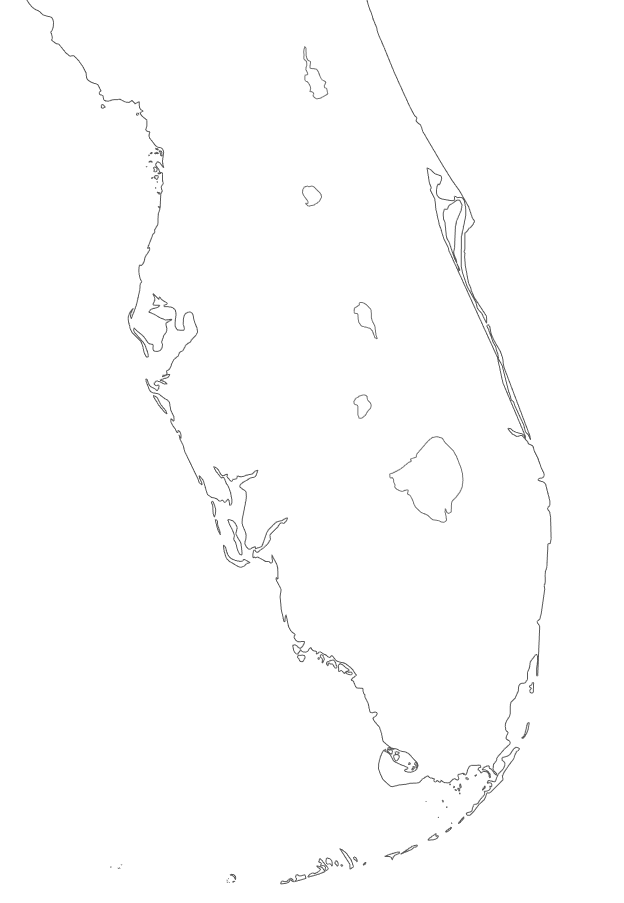
›
Document Scanning Predictions
- Predicting "Date Due" from an invoice
-
Optical Character Recognition (OCR)
- Know where every character/word is on the page
- Find correct "Date Due" on the document
-
Generate a
Heatmap
of correct "Date Due" pixels
- Scale all points so 1 is the highest number

-
Predictor: For any candidate date
- average the value of the "pixels" it covers from the heat map
- Higher the number the better
›
Too many Categories
-
Fraud Model

-
Unsupervised on all the predictors
-
Number of clusters in 1000s
- Crazy!
-
Crazy Brilliant
- Fraud is a rare event
- Most clusters were garbage
- Others full of fraud
- Inspected them
- Grouped these bad clusters together
- Extra boolean feature fed into the final fraud model
-
Number of clusters in 1000s
Bonus - Proximity to an internation airport
›Failures > Success
- What features are good?
- Plot it!
-
Rank features from best to worst
- p-value / Z-score (with caveats)
- Binning and difference with Mean (weighted / unweighted)
- Random Forest Variable Importance Ranking
›
Plotting
-
Crazy Important 🧼📦:

- See the actual relationship
-
Predictor / Response type Dependant
-
Response: Boolean / Categorical
-
Predictor: Boolean / Categorical
- Heatplot
-
Predictor: Continous
- Violin plot on predictor grouped by response
- Distribution plot on predictor grouped by response
-
Predictor: Boolean / Categorical
-
Response: Continuous
-
Predictor: Boolean / Categorical
- Violin plot on response grouped by predictor
- Distribution plot on response grouped by predictor
-
Predictor: Continuous
- Scatter plot with trendline
-
Predictor: Boolean / Categorical
-
Response: Boolean / Categorical
›
Categorical Response / Categorical Predictor
Categorical Response / Categorical Predictor
Categorical Response / Continuous Predictor
Categorical Response / Continuous Predictor
Continuous Response / Categorical Predictor
Continuous Response / Categorical Predictor
Continuous Response / Continuous Predictor
An extra reason to plot
-
Target Leakage
-
Nostradamus
Variables

- Accidentally leak the response into the predictor
-
Nostradamus
Variables
-
Obvious when plotted
- If model is too good
- Always check the best performing predictors
- Need to rank predictors
›
p-value and Z/t-score
-
Statistics (
statsmodels)-
Linear Regression
- Continuous response
-
Logistic Regression
- Boolean response
-
Linear Regression
›
Regression p-value & t-score
Dataset information
- Diabetes Dataset
- Ten baseline variables, age, sex, body mass index, average blood pressure, and six blood serum measurements were obtained for each of n = 442 diabetes patients, as well as the response of interest, a quantitative measure of disease progression one year after baseline.
-
Predictors
- age in years
- sex
- bmi body mass index
- bp average blood pressure
- s1 tc, T-Cells (a type of white blood cells)
- s2 ldl, low-density lipoproteins
- s3 hdl, high-density lipoproteins
- s4 tch, thyroid stimulating hormone
s5 ltg, lamotrigine s6 glu, blood sugar level
›
Regression p-value & t-score
Diabetes - Age Summary Statistics
Diabetes - Regression Code - Plot
Regression p-value & t-score
Diabetes - Sex Summary Statistics
Diabetes - BMI Summary Statistics
Diabetes - BP Summary Statistics
Not Perfect
-
Linear Regression
- The problem is in it's name!
- Non-linear relationships?
›
Difference with mean of response - Aggregation
-
Formula
- Bin candidate predictor variable
- Compute the average value of response for the predictors in each bin
- Compare this with the population average response
- Square the difference, sum them up and divide by number of bins
$$ \frac{1}{n}\sum_{i=1}^{i \leq n}{{\left(\mu_{i} - \mu_{pop}\right)}^{2}} $$where $i$ is a bin & $n$ is the number of bins
-
Bigger the number, better the predictor
- Plot it! ($\mu_{i}-\mu_{pop}$ vs. bins)
- Could just be noise
- Look for patterns
›
Difference with mean of response
Difference with mean table
| ($i$) | LowerBin | UpperBin | BinCenters | BinCount | BinMeans ($\mu_{i}$) | PopulationMean ($\mu_{pop}$) | MeanSquaredDiff |
|---|---|---|---|---|---|---|---|
| 0 | -3.563517 | -2.930781 | -3.247149 |
1
|
-3.616800 | 0.014081 |
13.183300
|
| 1 | -2.930781 | -2.298045 | -2.614413 |
2
|
-2.641231 | 0.014081 |
7.050685
|
| 2 | -2.298045 | -1.665308 | -1.981676 | 22 | -1.900161 | 0.014081 | 3.664322 |
| 3 | -1.665308 | -1.032572 | -1.348940 | 43 | -1.310229 | 0.014081 | 1.753797 |
| 4 | -1.032572 | -0.399836 | -0.716204 | 94 | -0.671962 | 0.014081 | 0.470656 |
| 5 | -0.399836 | 0.232900 | -0.083468 | 129 | -0.070665 | 0.014081 | 0.007182 |
| 6 | 0.232900 | 0.865636 | 0.549268 | 120 | 0.487407 | 0.014081 | 0.224037 |
| 7 | 0.865636 | 1.498372 | 1.182004 | 59 | 1.158775 | 0.014081 | 1.310324 |
| 8 | 1.498372 | 2.131108 | 1.814740 | 25 | 1.875793 | 0.014081 | 3.465971 |
| 9 | 2.131108 | 2.763844 | 2.447476 |
5
|
2.522430 | 0.014081 |
6.291814
|
| 37.42208/10 = 3.74 |
Difference with mean of response - Issues
-
Some bins have very small populations
- Weigh the squared difference by population proportion before $ \sum{} $
$$ \sum_{i=1}^{i \leq n}{w_i{\left(\mu_{i} - \mu_{pop}\right)}^{2}} $$ -
Adjust the tails of the bins
-
Force the tails to contain a certain population proportion
- $ \geq 5\% $
-
Force the tails to contain a certain population proportion
-
If you have
NULLs- It could be predictive in itself
- Make a separate bin for it
- Include it's calculation
›
Difference with mean table (weighted)
| ($i$) | LowerBin | UpperBin | BinCenters | BinCount | BinMeans ($\mu_{i}$) | PopulationMean ($\mu_{pop}$) | MeanSquaredDiff | PopulationProportion ($w_{i}$) | MeanSquaredDiffWeighted |
|---|---|---|---|---|---|---|---|---|---|
| 0 | -3.563517 | -2.930781 | -3.247149 | 1 | -3.616800 | 0.014081 | 13.183300 | 0.002 |
0.026367
|
| 1 | -2.930781 | -2.298045 | -2.614413 | 2 | -2.641231 | 0.014081 | 7.050685 | 0.004 |
0.028203
|
| 2 | -2.298045 | -1.665308 | -1.981676 | 22 | -1.900161 | 0.014081 | 3.664322 | 0.044 | 0.161230 |
| 3 | -1.665308 | -1.032572 | -1.348940 | 43 | -1.310229 | 0.014081 | 1.753797 | 0.086 | 0.150827 |
| 4 | -1.032572 | -0.399836 | -0.716204 | 94 | -0.671962 | 0.014081 | 0.470656 | 0.188 | 0.088483 |
| 5 | -0.399836 | 0.232900 | -0.083468 | 129 | -0.070665 | 0.014081 | 0.007182 | 0.258 | 0.001853 |
| 6 | 0.232900 | 0.865636 | 0.549268 | 120 | 0.487407 | 0.014081 | 0.224037 | 0.240 | 0.053769 |
| 7 | 0.865636 | 1.498372 | 1.182004 | 59 | 1.158775 | 0.014081 | 1.310324 | 0.118 | 0.154618 |
| 8 | 1.498372 | 2.131108 | 1.814740 | 25 | 1.875793 | 0.014081 | 3.465971 | 0.050 | 0.173299 |
| 9 | 2.131108 | 2.763844 | 2.447476 | 5 | 2.522430 | 0.014081 | 6.291814 | 0.010 |
0.062918
|
| 37.42208/10=3.74 | 1.0 | 0.901566 |
Random Forest
-
Variable Importance
- Great for variable ranking
- sklearn has this as feature_importances_
- Good segwe into decision trees
›
Decision Trees
-
How do they work?
-
Look at all the data for a branch
- Look at all the predictors, how do we maximize
- Gini
- Information Gain (Entropy)
- Split on it
-
Repeat until we have everything categorized correctly or hit
stopping criteria
-
Overfits!
- Fit to the noise
- Don't over grow
-
Pruning
-
Cross Validation

- Where to cut branches
-
Cross Validation
-
Overfits!
-
Look at all the data for a branch
-
sklearn.tree.DecisionTreeClassifier
›
Decision Tree - Building
›
Fisher's Iris Data set
-
150 observations
- 50 samples from each of the species of Iris
- 4 predictors
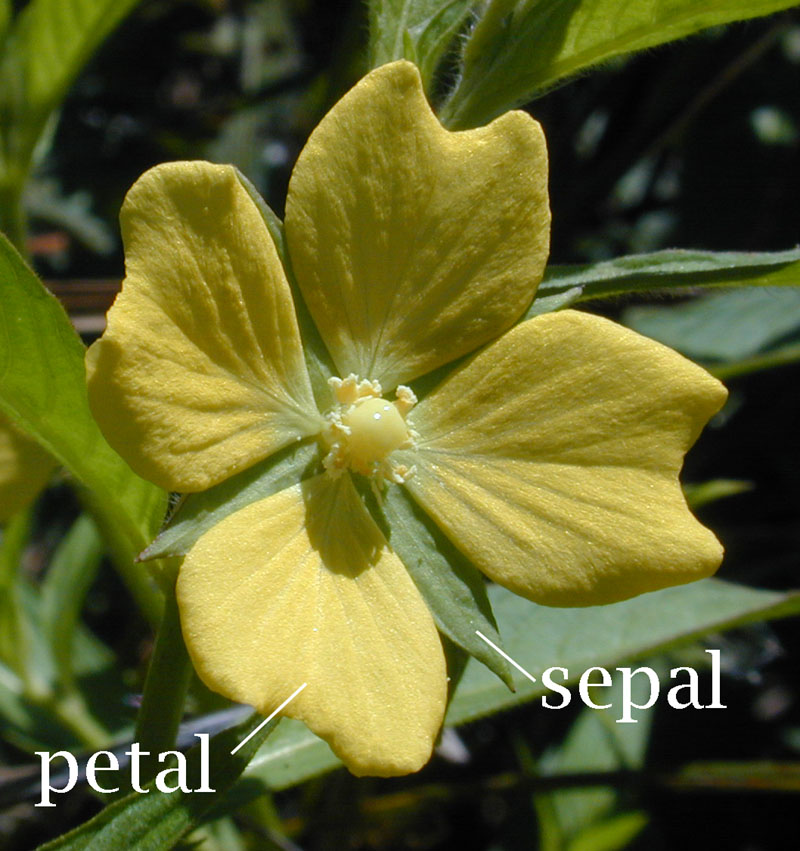
›
Decision Tree - Building
Decision Tree - Original Dataset
********************************************************************************
Original Dataset
********************************************************************************
sepal_length sepal_width petal_length petal_width class
0 5.1 3.5 1.4 0.2 Iris-setosa
1 4.9 3.0 1.4 0.2 Iris-setosa
2 4.7 3.2 1.3 0.2 Iris-setosa
3 4.6 3.1 1.5 0.2 Iris-setosa
4 5.0 3.6 1.4 0.2 Iris-setosa
.. ... ... ... ... ...
145 6.7 3.0 5.2 2.3 Iris-virginica
146 6.3 2.5 5.0 1.9 Iris-virginica
147 6.5 3.0 5.2 2.0 Iris-virginica
148 6.2 3.4 5.4 2.3 Iris-virginica
149 5.9 3.0 5.1 1.8 Iris-virginica
[150 rows x 5 columns]
Decision Tree - Building
Decision Tree - Unpruned Tree
Decision Tree - Pruning
Decision Tree - Cross Validation Score
| criterion | max_depth | score | |
|---|---|---|---|
| 0 | gini | 1 | 0.666667 |
| 1 | gini | 2 | 0.933333 |
| 2 | gini | 3 | 0.960000 |
| 3 | gini | 4 | 0.966667 |
| 4 | gini | 5 | 0.960000 |
| 5 | gini | 6 | 0.960000 |
| 6 | entropy | 1 | 0.666667 |
| 7 | entropy | 2 | 0.933333 |
| 8 | entropy | 3 | 0.960000 |
| 9 | entropy | 4 | 0.953333 |
| 10 | entropy | 5 | 0.953333 |
| 11 | entropy | 6 | 0.953333 |
Decision Tree - Plotting the score
Decision Tree - Pruning Plot
Decision Tree - Plotting the optimal tree
Decision Tree - Pruned Tree
Decision Tree - Overfitting
- Probably the biggest problem
- Running this on the titanic dataset
Titanic - Cross Val Negative Mean Squared Error
Bootstrap Aggregating (Bagging)
-
Bootstrap
- Sample with replacement from dataset
-
Aggregating
- Build many trees and agregate their results
-
sklearn.ensemble.BaggingClassifier- Wrapper for any classifier
›
Bagging - Code
Bagging - Trees
Random Forest
- Original Paper
-
Builds on bagging
-
Many trees (aggregate)
- Each tree built from a sample of values (bootstrap)
-
Each split picks from a
random subset of predictors
- Usually $ \sqrt{n} $
- $n = $ number of predictors
-
Many trees (aggregate)
›
Random Forest - Variable Importance
-
Impurity Based feature importance (Gini importance)
-
sklean.ensemble.RandomForestClassifier.feature_importances_ - Uses the out-of-bag error 🤷
- Biased toward categorical predictors with high cardinality
-
-
Permutation based feature importance
-
sklearn.inspection.permutation_importance - Will actually work with any classifier!
-
›
In Summary
-
Features
- Continuous: Easy
-
Categorical: Harder
- One-hot
- Dummy
- Ranking
- Embedding
- Vector
-
Feature Engineering
- Best way to increase a model's accuracy
- Always plot predictons!
-
Variable Importance rankings
- p-value & z/t score
- Difference with mean of response
- Random Forest variable importance
Homework - Assignment 4 - (1/2) Due Marth 17th
- Branch must be named
hw_04
git checkout -b hw_04- Contains both a response and predictors
- Determine if response is continuous or boolean (don't worry about >2 category responses)
-
Loop through each predictor column
-
Determine if the predictor is cat/cont (no tricks)
- "string" == Categorical
- number == Continuous
- Automatically generate the necessary plot(s) to inspect it
- ...
-
Determine if the predictor is cat/cont (no tricks)
Homework - Assignment 4 - (2/2) Due Marth 17th
-
Loop through each predictor column
- ...
-
Calculate the different ranking algos
-
p-value & t-score (continuous predictors only) along with it's
plot
- Regression: Continuous response
- Logistic Regression: Boolean response
- Difference with mean of response along with it's plot (weighted and unweighted)
- Random Forest Variable importance ranking (continuous predictors only)
-
p-value & t-score (continuous predictors only) along with it's
plot
- Generate a table with all the variables and their rankings
- I'm going to grade this by giving it some random dataset and seeing if it outputs everything
- Desire: html (hint 1 or hint 2) based rankings report with links to the plots
